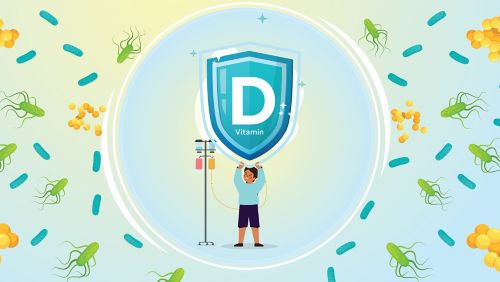St. Jude Family of Websites
Explore our cutting edge research, world-class patient care, career opportunities and more.
St. Jude Children's Research Hospital Home

- Fundraising
St. Jude Family of Websites
Explore our cutting edge research, world-class patient care, career opportunities and more.
St. Jude Children's Research Hospital Home

- Fundraising
Nutrition is a key ingredient for defense against infectious diseases in kids with cancer

An artistic rendering of how higher vitamin D levels may be helping children with acute lymphoblastic leukemia resist infections during treatment. Graphic by Briana Williams.
In every country and culture, sitting down and sharing a meal is a time-honored tradition. From activating ancient rules of hospitality to facilitating business dealings, food plays an essential societal role. But a family meal takes on a different importance when a child is being treated for cancer. Food determines nutritional status, which is particularly important for people undergoing treatment for an illness.
“Patients who are adequately nourished do better through cancer treatment,” said Carla Cartwright, RDN, LDN, CNSC, St. Jude Department of Clinical Nutrition senior dietician. “During the treatment process, many parents can feel they lack the ability to contribute meaningfully. Supporting nutrition is one thing that they can do to help their child.”
During cancer treatment, children can face hurdles to maintaining healthy eating. Chemotherapy has many side effects, including loss of appetite, dysgeusia, mouth sores, and nausea and vomiting — but that is not all patients go through.
“It’s not just chemotherapy’s side effects that we worry about,” said Sara Oaks, MS, RDN, LDN, St. Jude Department of Clinical Nutrition senior dietician. “Our patients are at nutritional risk for a variety of other reasons, including radiation-induced side effects, post-surgical procedures and acute illnesses they are susceptible to from immunosuppression therapy. Each factor contributes to them not feeling like eating, then not eating enough.”
Over time, patients often lose weight and don’t get enough nutrients. The dieticians’ primary concern is macronutrients, such as carbohydrates, proteins and fats, as patients tend to be deficient in these major categories. The primary intervention is to facilitate eating and escalate approaches as needed. This process can be as simple as adding a dietary supplement or as involved as adding a feeding tube. The goal is to intervene with sustainable solutions to prevent nutritional deficiencies.
“Poor nutritional status doesn’t happen overnight, and we’re not going to fix it overnight,” Cartwright explained.
When a patient meets their macronutrient requirements, micronutrients are deemphasized. If a patient is suspected to be deficient, micronutrient deficiencies are evaluated. One example of such a micronutrient is vitamin D.
“If we are highly suspicious of a vitamin D deficiency, we check it and supplement to return it to normal levels,” Oaks said. “While we don’t routinely check, new evidence suggests that maybe we should.”
Vitamin D and decreased infection risk in childhood cancer treatment
Infectious diseases are the most important life-threatening complications of cancer treatment in children because their treatments often compromise the immune system. Even minor improvements in preventing infections, therefore, have the potential to save lives. This motivates researchers at St. Jude and elsewhere to identify alterable risk factors for infection. In a recent study, researchers at St. Jude showed that patients undergoing treatment for acute lymphoblastic leukemia (ALL) with vitamin D deficiency experienced a higher infection risk than those with adequate vitamin D levels, as published in The Journal of Pediatrics.
“We found that patients with low vitamin D levels had significantly increased risk for many different infectious syndromes,” said senior co-corresponding author Joshua Wolf, MBBS, PhD, St. Jude Department of Infectious Diseases. “Low vitamin D levels almost doubled the risk of serious infections. We had Dr. Li Tang of the Department of Biostatistics to analyze the effect, and she was able to show that it still existed even after we accounted for different factors that might otherwise explain the increase.”
The researchers chose to study vitamin D because it is known to be involved in immune function. The vitamin plays a major role in immune gene transcription, being ferried from outside certain immune cells all the way to their DNA to control gene expression. That functionality gives one plausible explanation for why vitamin D levels impact infections.
“However, we don’t understand all the connections between vitamin D and infections,” said co-corresponding author Julia Hurwitz, PhD, St. Jude Department of Infectious Diseases, who has spent much of her career studying the interaction of vitamins and the immune system. “Vitamin D can have both direct and indirect effects. In our study of ALL, we identified an association, not the casual relationships.”
The scientists examined vitamin A and D levels before treatment, then confirmed infections, reported fevers, neutropenia (low numbers of immune cells) and many potential confounding variables in patients who underwent therapy for ALL at St. Jude. The presence of Vitamin D deficiency before treatment was associated with a large increase in the likelihood of a bacterial infection and secondary signs of infection, such as fever, during treatment. Interestingly, there wasn’t any sign that low vitamin A levels increased the risk of infection.
“Low vitamin D at baseline was associated with multiple infectious diseases in children with ALL,” Hurwitz said. “Future studies may determine if and how different vitamin supplementation programs improve outcomes and what regimens are optimal.”
Driving down deficiencies in pediatric patients with cancer
While the exact nature and dosage of vitamin D supplementation and its relationship to infection risk may be unclear, nutrition experts already provide vitamin D supplementation for deficiency in various diseases, including cancers. Unlike many potential cancer therapy improvements, the technology and treatment already exist. The main barrier is changing standard operating procedures to screen patients’ vitamin D levels and optimize how to help those with low amounts.
“While we don’t routinely check for vitamin D deficiency, it would be easy to incorporate,” Cartwright said. “It’s an easy lab blood draw and often resulted on the same day. We already have protocols for supplementation, so adding it into standard care would be very feasible.”
As families gather for meals, they discuss their days, exchange ideas, and maybe even share a few laughs. When a family with a child that is about to start cancer treatment eats, they can be full of anxiety and feel overwhelmed. Through nutrition, they can take some control and know that incorporating healthy foods into their child’s meals may give them the best chance to prevent or fight off potentially lethal infections once they begin therapy.
“We know that infections can be fatal to children undergoing immunosuppressive therapies,” Wolf concluded. “This study adds to the growing body of evidence that good nutrition is one more ingredient we can add to the recipe we use to keep our kids safe from infections during cancer treatment.”
Read updated food guidelines for children with cancer, co-authored by Wolf.






